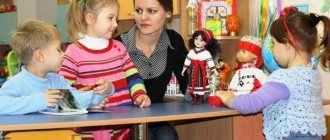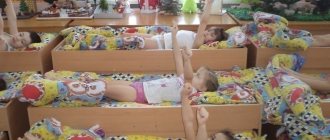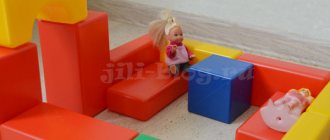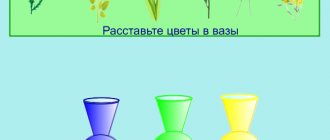Role-playing game based on the Russian folk tale “Kolobok” for children of the middle group
Theatrical activities. Role-playing game based on the Russian folk
tale “Kolobok” (for children of the middle group) Purpose:
to develop in preschool children the skills of safe behavior in the environment, communication skills through role-playing games.
Tasks:
- consolidate children’s previously acquired knowledge about the rules of behavior and communication in role-playing games;
- develop the ability to play according to one’s own plans, encourage children’s creative activity in play;
- consolidate knowledge and skills of cultural behavior in public places (theater);
- develop analytical and synthetic activities based on situation analysis;
- develop dialogical speech, contribute to the enrichment of passive and active vocabularies;
- cultivate a culture of behavior and communication.
Attributes for the game:
complimentary ticket;
costumes for the dramatization of the fairy tale “Kolobok”; game character masks; children's tables and chairs, poster; tickets to the performance in the form of cut-out pictures depicting a bun, grandfather, grandmother, hare, bear, wolf, fox; forest decoration (trees, mushrooms, stump, flowers); emoticons in the form of a bun. Vocabulary work:
poster, auditorium, intermission, stranger, rules of communication, culture of communication.
Methods and techniques:
creating a game environment, staging a fairy tale, conversation, highlighting a problem situation, modeling communication situations, elements of brainstorming, play, reflection.
Preliminary work:
- production of posters, tickets;
- reading the fairy tale “Kolobok”;
- drawing based on the fairy tale “Kolobok”;
- role-playing game "Theater";
- guessing riddles about animals;
- examination of illustrations for the fairy tale “Kolobok”;
- classes on rules of behavior and communication.
Pedagogical development of the game plan:
- Creating a gaming moment using an invitation ticket to the theater.
- Developmental exercise “Cut pictures”.
- View a dramatization of a fairy tale.
- Conversation on the content of the fairy tale.
- Identification of a problem situation.
- An element of “brainstorming” with the search for a solution to the situation.
- Distribution of playing roles taking into account the interests and wishes of children.
- Acting out communication situations suggested by children.
- Game analysis.
- Reflection.
Progress of the role-playing game:
- Familiarize children with the game plan.
The teacher-psychologist informs the children about the game plan: “Guys, I know that you really love fairy tales. Today we will visit a real theater, where we will watch a play, reflect on its content, the behavior of the main character, and become participants in a fairy-tale game ourselves.”
- Creating an imaginary situation.
The teacher-psychologist shows the children an invitation card: “Guys, today an invitation card arrived at our kindergarten. You and I are invited to visit the theater. But before you go to the theater, you need to remember the rules of conduct in it.”
Children voice the rules of behavior in the theater:
— Enter the auditorium before the start of the performance.
- Do not make noise during the performance. — Before the performance, turn off mobile phones. — Artists are greeted and seen off with applause. - Walk to the spectator seat facing those who have already taken their place. — During the intermission, you can leave the hall and visit the buffet. Together with a teacher-psychologist, children go to an imaginary auditorium where forest scenery is displayed. Developmental exercise “Cut pictures”.
The educational psychologist reports: “At the entrance to the auditorium, everyone must present an entrance ticket.
To get such a ticket, you must collect cut pictures from several parts. Each of you has your own split picture. The pictures will help us guess what kind of performance we will watch. Children collect cut-out pictures. Brief conversation:
- Guys, what characters did you create for the play?
(grandmother, grandfather, bun, hare, wolf, bear, fox). - What fairy tale will we watch? (“Kolobok”). You and I will knock quietly on the house. Grandma will feed you - the pies are in the oven. Grandfather will tell us about Kolobok. How Baba once baked it. The teacher-psychologist shows the children a poster for the fairy tale “Kolobok” and invites the children to take seats in the improvised auditorium. A dramatization of the fairy tale “Kolobok” (performed by children of the middle group). Conversation:
- Guys, where did Kolobok come from in the fairy tale? (grandmother baked it).
- Who did Kolobok meet in the fairy tale? (children list animals).
- What happened to Kolobok in the fairy tale? (he was eaten by a fox).
- Why did it happen? (the bun did not listen to his grandparents, he communicated with unfamiliar animals, the fox deceived him).
Children identify the problem
:
Kolobok behaved incorrectly with strangers. Elements of brainstorming.
The teacher-psychologist invites the children to come up with situations of communication with animals in which Kolobok would not be harmed.
Expected answers from children:
- Do not leave home without warning adults.
- Do not boast about your behavior in front of strangers. - Deal with animals politely. - Don't talk to strangers. - Make friends with animals. - Do not walk alone in the forest, in an unfamiliar place. — When meeting strangers, call for help. During the discussion, the educational psychologist clarifies each answer option.
- Distribution of roles.
The educational psychologist clarifies the children’s desire to fulfill a particular role. All roles go to children. During the game, the educational psychologist plays the role of coordinator and assistant, suggesting situations from a fairy tale for execution.
- A game.
During the game, children act out situations from a fairy tale:
- communication with grandparents, where grandparents do not leave Kolobok unattended, tell him the rules of walking and communication;
- communication with animals;
- call for help;
- inviting animals to take a walk together.
- Ending the game.
The teacher-psychologist invites children to formulate rules of behavior and communication.
Suggested rules:
- Adults should not leave children unattended.
- Don't communicate with strangers.
- Don't be on the street alone.
- Don't trust strangers.
- If an emergency occurs, call for help.
Reflection:
The teacher-psychologist invites children to choose emoticons in the form of a kolobok with the mood that matches the mood of the children in the game.
Mathematics lesson in the junior group of kindergarten. Kolobok
Abstract of GCD in mathematics in the junior group of kindergarten "Kolobok"
Description: this summary of GCD is interesting for its integrated selection of tasks and exercises. For teachers of the younger group, it will help to be a support in drawing up notes in preparation for classes. Goal: systematization, consolidation and generalization of children’s knowledge Tasks: - consolidate knowledge about geometric shapes (cube - ball, circle - square) - use the expressions “how many”, “many”, “one”, - consolidate the ability to compare objects by size: “ big”, “small” - consolidate the ability to select words that have opposite meanings. - promote the development of auditory and visual attention, memory, logical thinking; - develop fine motor skills. - promote emotional rapprochement between children. - bring children joy and pleasure from joint activities. Integration of educational areas: Cognition, Communication, Socialization Equipment: bun; toys: bear, wolf, hare, fox; tray. demonstration material : teaching aid “fix the rug”;
cube and ball, circle and square; balls and cubes for the game “Collect”, mushrooms and cones for the game “Collect”, pies, buns for treating the fox. Progress of the lesson
Children enter the group. The teacher asks you to stand in a circle. Educator: Guys, we have guests today.
Let's say hello to them. Well done! Educator: Guys, please tell me, what is your mood today?
Children: Good, excellent, wonderful, super excellent, kind, affectionate, cheerful. Educator: Okay, then let's share our mood with each other. Let's hold hands and stand in a circle. (Children stand in a circle, the game “Hello” is played. Educator: Guys, a guest came to us today, and to guess who he is, listen carefully. Educator: That’s right, it’s a bun! Let’s say hello to him. The teacher shows a toy bun. Children : Gingerbread man. Educator: Look, carefully and tell me what a kolobok looks like? A kolobok looks like a cube or a ball. Why do balls and balls roll, but cubes and cubes don’t? What’s stopping them? (Angles) Didactic game “Collect balls and cubes” Educator: What shape does a ball look like? (Circle) What shape does a cube look like? (Square) Educator: Kolobok likes to play motorists. He prepared cars for you. Circles or squares are drawn on them. Whoever has a circle on his car goes to garage with a round sign, and who has a square in a garage with a square sign. Educator : Let's give Kolobok a rug. The teacher unrolls the carpet, but it is ruined. Educator: Guys, look, the mouse ruined our carpet. Guys, let's fix our rug. What shapes? Are our holes similar? Children: Circle, square. Educator: The guys sort out the figures on the tray. Didactic game “Fix the carpet” Educator: Guys, look at your patches, what shape do you have in your hands and what color is it? Each child answers the question posed. Children's answers Educator: Guys, someone is coming to us. I'll read you a riddle, and you guess who it is? Gray animal leaps over the hummocks! Light legs and a little tail! Children: Hare. Hare: Kolobok, Kolobok, I’ll eat you! Educator: Don’t eat his bunny, he’s our friend. Hare: Okay, I’ll let the bun go if you help me. Educator: Guys, let's help the bunny. You and I must put the cones and mushrooms into baskets. Game "Collect cones and mushrooms." Educator: Let's check if we completed the task correctly. Hare: Thank you guys for helping me. I won't eat your Kolobok. Kolobok is your good and faithful friend - take care of them! Goodbye, guys! Educator: Guys, someone is coming to us again. He prowls the forest at night, looking for food for himself. It's scary to hear the mouth click... Who has the teeth in the forest? ... Children: Wolf Wolf: Kolobok, Kolobok, I’ll eat you. Children: Don't eat him, he's our friend! Wolf: Oh, there are so many of you! Well, I won’t eat it if you tell me the opposites correctly. Educator: Guys, let's stand in a circle with you. I will tell you a proposal, and you will tell me the opposite of it. It’s warm in summer and cold in winter. The elephant is big and the mouse is small. The wolf is evil and the bunny is good. Fruits grow high and vegetables grow low. It’s light during the day and dark at night. The table is high and the chair is low. Soup hot, but ice cream (cold) There is only one teacher, but there are many children. Wolf: How smart you guys are, I want to be smart too, I’ll run to the fairy-tale kindergarten too! Take your Kolobok Goodbye! Children: Goodbye. Educator: Guys, someone is coming to us again. He is big and club-footed, he loves to suck paws. He loves to roar, and his name is... Children: Bear Bear: bun, bun, I'll eat you! Children: Bear, don’t eat the kolobok. Bear: Okay, I’ll let the bun go if you play for me. Educator: Guys, let’s play with you the game “At the Bear in the Forest.” I pick mushrooms and berries from the bear in the forest. But the bear is not sleeping, He keeps looking at us, And then he growls and runs after us! Bear: Thanks guys. You made me laugh. I will release the bun, as promised! Happy stay. Educator: Guys, someone is coming to us again, the cunning rogue Red Head. The fluffy tail is beautiful! And her name is..... Children: Fox Fox: What a delicious little bun. Kolobok, Kolobok, I will eat you! Children: Fox, don’t eat the kolobok, he’s our friend. Lisa: Well, no. If I let him go, I'll get very bored. Who will I play with? Educator: Play with us, and we will treat you to pies. Dance "Kolobok"
They treat the fox with pies.
The fox thanks and runs away. Final part Educator: Kolobok liked playing with you, and you? Did you find it difficult to complete tasks? Kolobok has prepared gifts for you. He says goodbye to you and goes to see his grandparents. Determining the prospects for future activities
We recommend watching:
Summary of GCD in mathematics in the younger group. The use of non-traditional forms of work in mathematics GCD for children of the junior group in mathematics “Bigger, smaller, smallest” Summary of a lesson in mathematics 2nd junior group “Geometric figures” Summary of a lesson on FEMP in the 2nd junior group. Journey to Geometry
Similar articles:
Summary of a mathematical game in the second junior group
Summary of the game in mathematics in the younger group
Mathematics lesson in the younger group “Parts of the day”
Summary of the lesson in mathematics “Number and figure 2”. Junior group
Summary of a mathematics lesson in the junior group “Coding geometric shapes”



